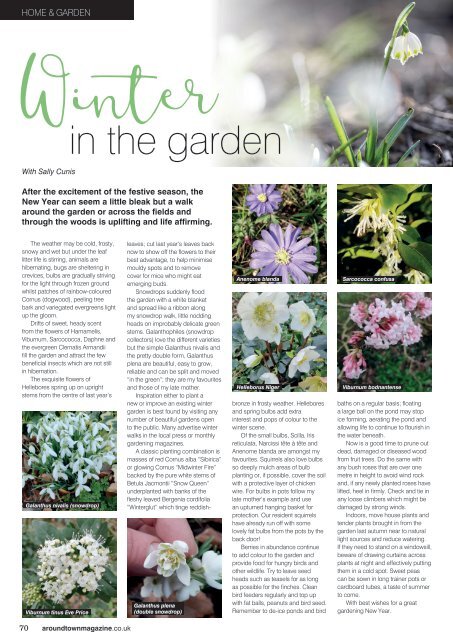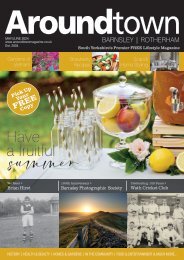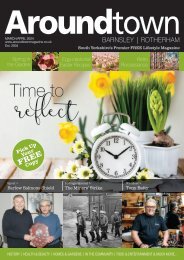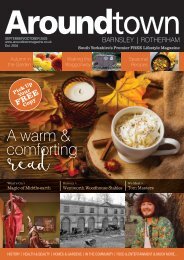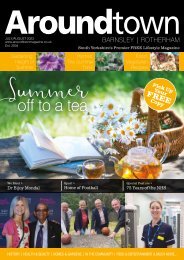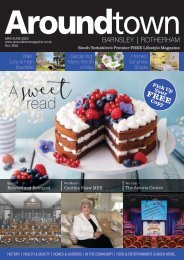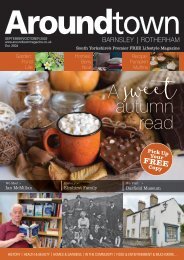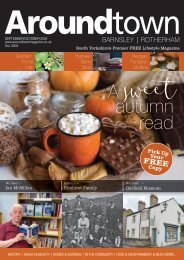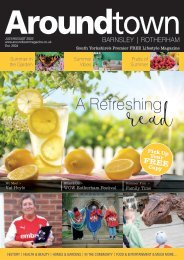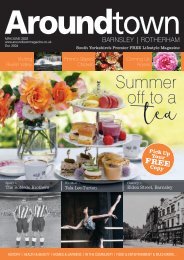Aroundtown Magazine January/February 2024 edition
Read the New Year edition of Aroundtown Magazine, South Yorkshire's premier free lifestyle magazine for Rotherham, Barnsley and Sheffield.
Read the New Year edition of Aroundtown Magazine, South Yorkshire's premier free lifestyle magazine for Rotherham, Barnsley and Sheffield.
You also want an ePaper? Increase the reach of your titles
YUMPU automatically turns print PDFs into web optimized ePapers that Google loves.
HOME & GARDEN<br />
Winter<br />
in the garden<br />
With Sally Cunis<br />
After the excitement of the festive season, the<br />
New Year can seem a little bleak but a walk<br />
around the garden or across the fields and<br />
through the woods is uplifting and life affirming.<br />
The weather may be cold, frosty,<br />
snowy and wet but under the leaf<br />
litter life is stirring, animals are<br />
hibernating, bugs are sheltering in<br />
crevices, bulbs are gradually striving<br />
for the light through frozen ground<br />
whilst patches of rainbow-coloured<br />
Cornus (dogwood), peeling tree<br />
bark and variegated evergreens light<br />
up the gloom.<br />
Drifts of sweet, heady scent<br />
from the flowers of Hamamelis,<br />
Viburnum, Sarcococca, Daphne and<br />
the evergreen Clematis Armandii<br />
fill the garden and attract the few<br />
beneficial insects which are not still<br />
in hibernation.<br />
The exquisite flowers of<br />
Hellebores spring up on upright<br />
stems from the centre of last year’s<br />
Galanthus nivalis (snowdrop)<br />
Viburnum tinus Eve Price<br />
Galanthus plena<br />
(double snowdrop)<br />
Anenome blanda<br />
Helleborus Niger<br />
leaves; cut last year’s leaves back<br />
now to show off the flowers to their<br />
best advantage, to help minimise<br />
mouldy spots and to remove<br />
cover for mice who might eat<br />
emerging buds.<br />
Snowdrops suddenly flood<br />
the garden with a white blanket<br />
and spread like a ribbon along<br />
my snowdrop walk, little nodding<br />
heads on improbably delicate green<br />
stems. Galanthophiles (snowdrop<br />
collectors) love the different varieties<br />
but the simple Galanthus nivalis and<br />
the pretty double form, Galanthus<br />
plena are beautiful, easy to grow,<br />
reliable and can be split and moved<br />
“in the green”; they are my favourites<br />
and those of my late mother.<br />
Inspiration either to plant a<br />
new or improve an existing winter<br />
garden is best found by visiting any<br />
number of beautiful gardens open<br />
to the public. Many advertise winter<br />
walks in the local press or monthly<br />
gardening magazines.<br />
A classic planting combination is<br />
masses of red Cornus alba “Sibirica”<br />
or glowing Cornus “Midwinter Fire”<br />
backed by the pure white stems of<br />
Betula Jacmontii “Snow Queen”<br />
underplanted with banks of the<br />
fleshy leaved Bergenia cordifolia<br />
“Winterglut” which tinge reddishbronze<br />
in frosty weather. Hellebores<br />
and spring bulbs add extra<br />
interest and pops of colour to the<br />
winter scene.<br />
Of the small bulbs, Scilla, Iris<br />
reticulata, Narcissi tête à tête and<br />
Anenome blanda are amongst my<br />
favourites. Squirrels also love bulbs<br />
so deeply mulch areas of bulb<br />
planting or, if possible, cover the soil<br />
with a protective layer of chicken<br />
wire. For bulbs in pots follow my<br />
late mother’s example and use<br />
an upturned hanging basket for<br />
protection. Our resident squirrels<br />
have already run off with some<br />
lovely fat bulbs from the pots by the<br />
back door!<br />
Berries in abundance continue<br />
to add colour to the garden and<br />
provide food for hungry birds and<br />
other wildlife. Try to leave seed<br />
heads such as teasels for as long<br />
as possible for the finches. Clean<br />
bird feeders regularly and top up<br />
with fat balls, peanuts and bird seed.<br />
Remember to de-ice ponds and bird<br />
Sarcococca confusa<br />
Viburnum bodnantense<br />
baths on a regular basis; floating<br />
a large ball on the pond may stop<br />
ice forming, aerating the pond and<br />
allowing life to continue to flourish in<br />
the water beneath.<br />
Now is a good time to prune out<br />
dead, damaged or diseased wood<br />
from fruit trees. Do the same with<br />
any bush roses that are over one<br />
metre in height to avoid wind rock<br />
and, if any newly planted roses have<br />
lifted, heel in firmly. Check and tie in<br />
any loose climbers which might be<br />
damaged by strong winds.<br />
Indoors, move house plants and<br />
tender plants brought in from the<br />
garden last autumn near to natural<br />
light sources and reduce watering.<br />
If they need to stand on a windowsill,<br />
beware of drawing curtains across<br />
plants at night and effectively putting<br />
them in a cold spot. Sweet peas<br />
can be sown in long trainer pots or<br />
cardboard tubes, a taste of summer<br />
to come.<br />
With best wishes for a great<br />
gardening New Year.<br />
70 aroundtownmagazine.co.uk


